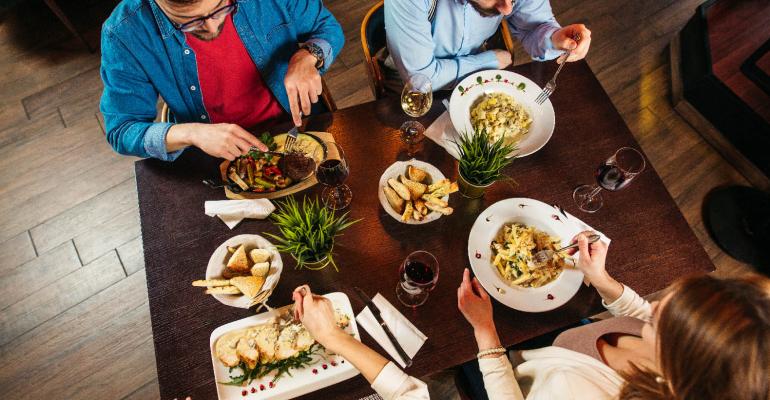Same-store sales growth for restaurants was 8.1% in July, an improvement of 1.3 percentage points compared to June’s results. This was the fifth consecutive month of positive sales growth for restaurants and the strongest sales growth for the industry in more than three years.
The industry is struggling to see growth in its guest counts. Same-store traffic growth was down 3.7% during June. Encouragingly, this is the smallest loss in guest counts recorded during any month since the beginning of the pandemic.
However, these results were achieved as COVID cases surged again throughout the country and the delta variant dominated the headlines. While its effect on restaurant sales and traffic seems to have been minimal during July, there is concern for a slowdown in sales and traffic in upcoming weeks if new infections continue rising rapidly. The downturn will be largely regional and focused on the new COVID hotspot states.
The relative strength of the industry is present in the percentage of positive “food” mentions from guests. Over 50% of comments on review sites and social media posts centered around restaurant “food” were classified as positive. The percentage of positive “food” mentions improved by 6.5 percentage points compared to July of 2019. Still, positive sentiment declined from the peak for the year, which was back in May.
The story is similar for service. Over 50% of reviews and social media posts that were based on restaurant “service” were classified as positive during July, an improvement of 4.8 percentage points in positive sentiment over two years. But as sales and traffic improved during the second quarter of 2021, positive “service” sentiment slipped.
“Ambiance” sentiment dropped the most during Q2 as guests returned to restaurants
The second quarter of 2021 brought a swell in restaurant sales and traffic. Same-store sales growth improved by 10 percentage points over Q1, while traffic improved by nine percentage points. But as more guests returned to restaurants, that put a lot of pressure on operators, especially considering the severe staffing crisis facing the industry in recent months. Given this convergence of factors, it was not surprising to find that guest sentiment slipped across all categories during Q2.
Sentiment based on restaurant “ambiance” dropped the most for both limited-service and full-service brands. Guests were aligned on what component of “ambiance” drove the decline as sentiment for “cleanliness” dropped significantly across the industry.
In the case of full-service restaurants, “cleanliness” net sentiment* dropped by 13 percentage points during the quarter. Some of the common themes mentioned regarding “cleanliness” focused on the tables and floor of the restaurant, high-touch items such as tableware and cutlery or the state of the bathrooms. Many of the comments signaled a return to basics in terms of “cleanliness,” touching upon the kind of expectations that existed pre-pandemic and not necessarily tying them back to the safety and health concerns that drove guests’ focus over the last year.
Similarly, “cleanliness” net sentiment for limited-service restaurants fell by 16 percentage points during the quarter. Although more than 70% of all limited-service sales continue to go through off-premises channels, there are challenges keeping restaurants clean for guests that decide to come in. The cleanliness-related themes commonly covered on online reviews during Q2 included assessments of tables and floors, bathrooms and mentions of trash found in various parts of the restaurant.
*Net sentiment is a value representing the percentage of positive mentions minus the percentage of negative mentions for a specific attribute of the restaurant experience.
Regional and market performance
The rapid rise in COVID cases in Florida has not yet affected most of its major markets. Orlando topped the list of metropolitan areas with the highest restaurant sentiment based on “food,” “beverage” and “ambiance,” while Tampa posted the most positive sentiment for restaurant “service.” Miami is the exception in Florida, with the lowest net sentiment during July based on “ambiance.” This attribute of the restaurant experience has been key during the COVID era due to its close connection to cleanliness. Furthermore, last month Miami barely made the bottom 10 based on the lowest “ambiance” sentiment. During July, its net sentiment tumbled 4.4 points and put them at the bottom of the list.
Things are also not looking bright for the San Francisco-Oakland-San Jose metropolitan area. This major market posted the worst restaurant same-store sales growth during July as well as the lowest net sentiment for restaurant “food” and “service.” It also had the second-lowest net sentiment based on guests’ stated “intent to return.”
Seattle, San Francisco, Miami and Boston were on the list of markets with the lowest “intent to return” sentiment during July, as well as the worst same-store sales results during the month.
The Restaurant Guest Satisfaction Snapshot™ (RGSS) is produced by data from Black Box Guest Intelligence™. Guest Intelligence is tracking over 190 brands to benchmark customer satisfaction and is the only online tool that integrates with operational performance data to validate the impact on financial performance. The data set focuses on six key attributes of the restaurant industry experience: food, service, ambiance, beverage, value and intent to return.
The RGSS algorithm determines the highest-ranking brands based on sentiment. Brands included in this monthly snapshot must have a total of at least 250 mentions for the month. Restaurants must have a minimum number of units to be eligible as well. DMA rankings consider only the largest 25 areas.
Metrics are “same-store” metrics and reported on a 2-year comparison unless otherwise noted

